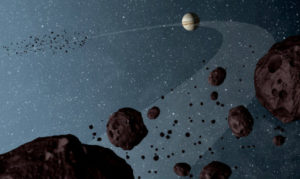Hordes of debris trapped by Jupiter and Neptune have distinct colors that mark them as possibly the last remnants of the material that built the giant planets.

NASA / JPL-Caltech
There’s a color conundrum among some of the smaller members of our solar system.
Jupiter and Neptune drag pockets of rocky debris on their treks around the Sun. Known as Trojans, these asteroid-like objects were likely swept up by the gravity of these two worlds. Swept up from where and when, though, has long been a mystery that could reveal details about how the young solar system evolved.
Well, the mystery keeps getting deeper. New observations build on previous hints that the Trojans at Jupiter and Neptune — despite being separated by billions of kilometers — have remarkably similar colors that don’t match any other small bodies in the solar system.
“Nature is giving us a little punch in the eye,” said David Jewitt (UCLA) during an October 23rd press conference at a meeting of the American Astronomical Society’s Division for Planetary Sciences.
Trojan asteroids lead and trail a planet as it orbits the Sun. They congregate at special points known as Lagrange points, where gravitational and orbital forces balance. One leading idea (of several) for their origin is that Trojans are lost souls from the Kuiper belt, the field of frozen debris beyond Neptune.
To test this idea, Jewitt compared the colors of 13 Neptunian Trojans to the colors of bodies in the Kuiper belt. They didn’t match. Neptune’s Trojans do, however, have similar colors to the Trojans near Jupiter, implying a common origin for both.
Astronomers have known for a while that Jupiter’s Trojans don’t match the Kuiper belt. Some researchers suspected that warmer temperatures near Jupiter could modify the surfaces of any visitors from the frigid Kuiper belt, thus changing their colors. But Jewitt said that doesn’t explain the color mismatch at Neptune, where the temperature is nearly the same as the Kuiper belt.
(Story continues after animation.)

Petr Scheirich (Astronomical Institute of the Czech Academy of Sciences)
“The Trojans are probably the last remnants of what formed the planets,” says Scott Sheppard (Carnegie Institution for Science). The planets are thought to have formed from lots of little things smashing together to make big things. The stuff that didn’t make it into a planet continued to orbit the Sun, and some of that debris could have gotten trapped where the Trojans live today.
Sheppard published a paper in 2006, along with Chad Trujillo (Northern Arizona University), that presented colors of the first four known Neptunian Trojans. Even then, there were hints that the Trojans were a separate family from everything else in the solar system. In the years since, that case has continued to build. “This new result doubles the sample size,” says Sheppard. “It continues to show this trend of being a very different population.” (See Sheppard's article in our June 2016 issue.)
Sarah Sonnett (Planetary Science Institute) agrees: “This is a very interesting result that provides constraints on where Neptune Trojans might have formed,” she says. “It consequently could help us understand how giant planets may have migrated early in solar system history.”
Most planetary scientists agree that the giant planets formed closer together and then migrated to their current orbits more than 4 billion years ago. If the Trojans were swept up during that time, they might have much to say about how the planets jockeyed for position. Some Jupiter Trojans, for example, are on highly inclined orbits. “That suggests a very chaotic environment,” Sheppard says. Planets effectively bouncing off one another could have stirred up the surrounding debris to create the Trojan orbits seen today.
“The Trojans have always been an overlooked population,” says Sheppard. They’re hard to observe and their spectra don’t reveal much. That’s where NASA’s Lucy mission might help. Scheduled to launch in 2021, it will spend seven years visiting six Jupiter Trojans (plus an asteroid in the belt between Mars and Jupiter), becoming the first probe to investigate this enigmatic population.
 0
0









Comments
You must be logged in to post a comment.